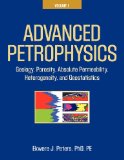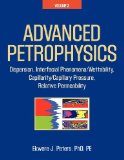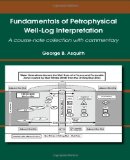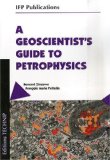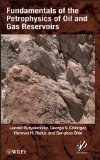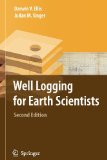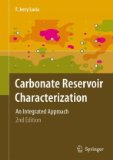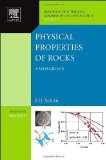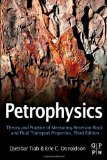
|
Petrophysics, 3rd Edition: Theory and Practice of Measuring Reservoir Rock and Fluid Transport Properties
This new edition includes updated case studies, examples and experiments as well as a new chapter on modeling and simulations. It also includes recent advances in wireline logging interpretation methods, effective media models, inversion of resistivity log measurements, dipole acoustic shear and Stoneley wave techniques, Biot-Gassmann models and MRI. Comprehensive but easy to use New case studies, exercises and worked examples A 30% update over the second edition Techniques for conducting competent quick-look evaluations Online component with step-by-step calculations, modeling and simulations, and experiments |
|
Advanced Petrophysics: Volume 1: Geology, Porosity, Absolute Permeability, Heterogeneity, and Geostatistics
A practical, fast-paced approach to teaching the concepts and problems common in petroleum engineering that will appeal to a wide range of disciplines Petrophysics is the study of rock properties and their interactions with fluids, including gases, liquid hydrocarbons, and aqueous solutions. This three-volume series from distinguished University of Texas professor Dr. Ekwere J. Peters provides a basic understanding of the physical properties of permeable geologic rocks and the interactions of the various fluids with their interstitial surfaces, with special focus on the transport properties of rocks for single-phase and multiphase flow. Based on Dr. Peters’s graduate course that has been taught internationally in corporations and classrooms, the series covers core topics and includes full-color CT and NMR images, graphs, and figures to illustrate practical application of the material. Subjects addressed in volume 1 (chapters 1–4) include • Geological concepts • Porosity and water saturation • Absolute permeability • Heterogeneity and geostatistics Advanced Petrophysics features over 140 exercises designed to strengthen learning and extend concepts into practice. Additional information in the appendices covers dimensional analysis and a series of real-world projects that enable the student to apply the principles presented in the text to build a petrophysical model using well logs and core data from a major petroleum-producing province. |
|
Advanced Petrophysics: Volume 2: Dispersion, Interfacial Phenomena/Wettability, Capillarity/Capillary Pressure, Relative Permeability
A practical, fast-paced approach to teaching the concepts and problems common in petroleum engineering that will appeal to a wide range of disciplines Petrophysics is the study of rock properties and their interactions with fluids, including gases, liquid hydrocarbons, and aqueous solutions. This three-volume series from distinguished University of Texas professor Dr. Ekwere J. Peters provides a basic understanding of the physical properties of permeable geologic rocks and the interactions of the various fluids with their interstitial surfaces, with special focus on the transport properties of rocks for single-phase and multiphase flow. Based on Dr. Peters’s graduate course that has been taught internationally in corporations and classrooms, the series covers core topics and includes full-color CT and NMR images, graphs, and figures to illustrate practical application of the material. Topics addressed in volume 2 (chapters 5–8) include • Dispersion in porous media • Interfacial phenomena and wettability • Capillary pressure • Relative permeability Advanced Petrophysics features over 140 exercises designed to strengthen learning and extend concepts into practice. Additional information in the appendices covers dimensional analysis and a series of real-world projects that enable the student to apply the principles presented in the text to build a petrophysical model using well logs and core data from a major petroleum-producing province. |
|
Advanced Petrophysics: Volume 3: Solutions
Volume 3 of Advanced Petrophysics presents the solutions to the 150 end-of-chapter exercises and projects in Volumes 1 and 2. |
|
Fundamentals of Petrophysical Well-Log Interpretation: A course-note collection with commentary
Petrophysical well-logs are incremental-depth records of rock, mineral, fluid, and other properties of the subsurface. Well logs and the practice of well-log interpretation by geologists and petroleum engineers represent a critical component of the exploration and assessment of potential hydrocarbon producing formations and reservoirs. The fundamentals of petrophysical well-log interpretation are presented in this monograph, which is a compilation of slide-oriented course notes and commentary created by the author over many semesters of undergraduate and graduate class-room instruction and is designed as a self-teaching guide with worksheets. Chapter 1 is an introduction to well-log interpretation, reviews discipline terminology, the types and uses of various well logs, and how the analyst might visually review logs in an effort to identify potentially productive zones of hydrocarbons. Chapter 2 introduces the reader the borehole environment and a view of the zones in a porous and permeable formation that has been invaded during drilling. The algorithmic steps are presented for computation of formation temperature from data on the log header. Chapters 3–7 present to the user the general information and characteristics of the various well logs including what individual well logs are designed to measure and how tool measurements are converted to appropriate units needed for hydrocarbon production assessment. Each chapter presents well-log analysis for two well-known Cretaceous formations: Glen Rose and Frontier. Chapter 8 reviews the critically important “Archie Parameters” that subsequently are used in Chapter 9 to compute the water saturations of the Glen Rose and Frontier formations using the Archie water-saturation equation. In prior worksheets, the reader is guided to the determination that the Frontier formation is a shaly sandstone and therefore the specific methods of “shaly-sandstone analysis” are required. Chapter 10 is a review of additional techniques used to progressively refine interpretation of the two formations through well-log analysis. Additional techniques demonstrated include guidance on the user answering the following questions: (1) Are the hydrocarbons calculated within Chapter 9 moveable? (2) Are the two formations “water-wet” or “oil-wet?” (3) What are the pore types within the Glen Rose? (4) Should the Glen Rose and Frontier formations individually make “water-free completions.” Similar to the other chapters, the information acquired and computations by the user are oriented around worksheets so that final interpretations of each formation can be made. Chapter 11 introduces and extensively reviews techniques useful for the evaluation of hydrocarbon potential in unconventional shale reservoirs using the standard well-log suite comprised of resistivity, neutron porosity, and bulk density logs. The techniques will be presented along with four case studies of the gas-bearing Woodford Shale and the three oil-bearing shales (Permian Leonard shale and two Permian Wolfcamp shales). Although the focus of the self-guided components of the monograph are generally restricted to a few select formations. The monograph includes considerable information and examples of, the well logs, host-rock properties (sandstones, shales, ...), and reservoirs within other formations discussed include: Ordovician Gunton; Devonian Marcellus; Mississippian Barnett, Chester, Mission Canyon; Pennsylvanian Canyon, Springer, Morrow, and Upper Morrow; Permian Bone Springs, Glorieta, and San Andres; Triassic Montney; Cretaceous Lewis, Pictured Cliffs, and Woodbine. The slides and commentary in this monograph are expected to be useful to a broad range of petrophysical well log analysts as tools to practical application as well as ascending for the beginner the formidable learning curve of petrophysical well-log interpretation. |
|
A Geoscientist's Guide to Petrophysics
Geoscientists and Engineers taking an interest in Petrophysics, are struck by the contrasting treatment of the Physics Aspects and the Geology Aspects. In most publications, the Physics Aspect prevails. The rock itself is considered as a black-box whose microscopic structure is briefly described as a model sometimes remote from reality.But if we are to scale up isolated petrophyscial observations to an entire oil reservoir or an aquifer, it is essential to implement the powerful extrapolation tool of geological interpretation. This is clearly based on a good understanding of the relations between the petrophysical parameters studied and the petrological characteristics of the rock considered.This Geological approach of Petrophysics is at the heart of our project.The book is divided into two sections of different size:The first section (by far the largest) describes the various petrophysical properties of rocks. Each property is defined, limiting the mathematical formulation to the strict minimum but emphasising the geometrical and therefore petrological parameters governing this property. The description of the measurement methods is restricted to an overview of the principles required for good communication between the geoscientist and the laboratory petrophysicist. For each property, we detail one or two aspects of the relations between petrophysics and geology (e.g. the porosity/permeability relations in carbonate rocks or irregular water tables and stratigraphic traps).The second section concentrates on methodological problems and concerns, above all, the representativeness of the measurements and the size effects. The notions of Representative Elementary Volume, Homogeneity, Anisotropy, Rock Type, etc. provide a better understanding of the problems of up-scaling (Plug, Core, Log Analysis, Well Test). Lastly, we provide a description of several Porous Network investigation methods: Thin section, Pore Cast, Visualization of capillary properties, X-ray tomography. Contents: 1. Petrophysical Properties and Relations with Petrology. Calculation of Fluid Volumes in Situ (Accumulations): Static Properties. Fluid Recovery and Modelling: Dynamic Properties. Log and Geophysical Analysis. 2. Scale Changes and Characterization of Porous Media: Methods and Techniques. Measurement Representativeness and Reservoir Characterization. Porous Network Observation Techniques. References. Porosity Terms Glossary-Index. Subject Index. Author Index. |
|
Fundamentals of the Petrophysics of Oil and Gas Reservoirs
Written by some of the world’s most renowned petroleum and environmental engineers, Petrophysics: The Fundamentals of Oil and Gas Revervoirs is the first book to offer the practicing engineer and engineering student these new cutting-edge techniques for prediction and forecasting in petroleum engineering and environmental management. |
|
Petroleum Reservoir Rock and Fluid Properties
A strong foundation in reservoir rock and fluid properties is the backbone of almost all the activities in the petroleum industry. Petroleum Reservoir Rock and Fluid Properties offers a reliable representation of fundamental concepts and practical aspects that encompass this vast subject area. The book provides up-to-date coverage of various rock and fluid properties using derivations, mathematical expressions, and various laboratory measurement techniques. Focused on achieving accurate and reliable data, it describes coring methods used for extracting samples from hydrocarbon formations and considerations for handling samples for conventional and special core analyses. Detailing properties important to reservoir engineering and surface processing, the author emphasizes basic chemical and physical aspects of petroleum reservoir fluids, important phase behavior concepts, fluid sampling, compositional analysis, and assessing the validity of collected fluid samples. The book also presents PVT equipment, phase behavior analysis using laboratory tests, and calculations to elucidate a wide range of properties, such as hydrocarbon vapor liquid equilibria using commonly employed equations-of-state (EOS) models. Covering both theoretical and practical aspects that facilitate the solution of problems encountered in real life situations, Petroleum Reservoir Rock and Fluid Properties is ideal for students in petroleum engineering, including those coming from different backgrounds in engineering. This book is also a valuable reference for chemical engineers diversifying into petroleum engineering and personnel engaged in core analysis, and PVT and reservoir fluid studies. |
|
Well Logging for Earth Scientists
The first edition of this book demystified the process of well log analysis for students, researchers and practitioners. In the two decades since, the industry has changed enormously: technical staffs are smaller, and hydrocarbons are harder to locate, quantify, and produce. New drilling techniques have engendered new measurement devices incorporated into the drilling string. Corporate restructuring and the "graying" of the workforce have caused a scarcity in technical competence involved in the search and exploitation of petroleum. The updated 2nd Edition reviews logging measurement technology developed in the last twenty years, and expands the petrophysical applications of the measurements. |
|
Basic Well Log Analysis, 2nd Edition
Basic Well Log Analysis is a general introduction to common openhole logging measurements, both wire line and MWD/LWD, and the interpretation of those measurements to determine the traditional analytical goals of porosity, fluid saturation, and lithology/mineralogy. It is arranged by the interpretation goals of the data, rather than by the underlying physics of the measurements. The accompanying CD-ROM contains digital versions of the data from the case studies, a summary guide to the measurements and their interpretation, and a simple spreadsheet containing some of the more common interpretation algorithms. This Second Edition of Basic Well Log Analysis delivers a great impact on training and self-training along with superior workbook exercises, newer measurements, borehole imaging, and nuclear magnetic resonance in separate chapters, all directed to provide a guide through the lengthy and sometimes ambiguous terminology of well logging and petrophysics. It provides readers with interpretation examples (and solutions) so that the techniques described here can be practiced. |
|
Carbonate Reservoir Characterization: An Integrated Approach
F. Jerry Lucia, working in America’s main oil-rich state, has produced a work that goes after one of the holy grails of oil prospecting. One main target in petroleum recovery is the description of the three-dimensional distribution of petrophysical properties on the interwell scale in carbonate reservoirs. Doing so would improve performance predictions by means of fluid-flow computer simulations. Lucia’s book focuses on the improvement of geological, petrophysical, and geostatistical methods, describes the basic petrophysical properties, important geology parameters, and rock fabrics from cores, and discusses their spatial distribution. A closing chapter deals with reservoir models as an input into flow simulators. |
|
Physical Properties of Rocks, Volume 8: A workbook
'Physical Properties of Rocks - a Workbook' is a symbiosis of a brief description of physical fundamentals of rock properties (based on typical experimental results and relevant theories and models) with a guide for practical use of different theoretical concepts. For this purpose a companion web site contains a selection of model based equations in excel worksheets for practical application and training by the user to work with his own data (or to ''play" in order to demonstrate the effects of various input information and to demonstrate the effects of various input information in petrophysical work. In two special chapters the problem of relationships between petrophysical parameters based on various model concepts is presented as a foundation for combined interpretation. This part also contains the author's 'structured model'. The workbook is a result of the more than 40 years experience of the author in teaching at universities and industrial courses. Presents all practical relevant properties of rock in one volume Experimental and theoretical fundamentals in a systematic framework Special focus on relationships between properties |































































